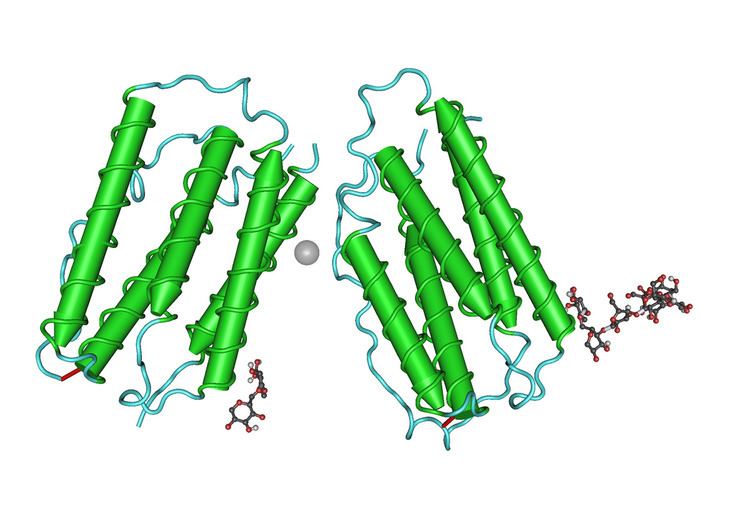 | ||
Human type I interferons (IFNs) are a large subgroup of interferon proteins that help regulate the activity of the immune system.
Contents
Interferons bind to interferon receptors. All type I IFNs bind to a specific cell surface receptor complex known as the IFN-α receptor (IFNAR) that consists of IFNAR1 and IFNAR2 chains.
Type I IFNs are found in all mammals, and homologous (similar) molecules have been found in birds, reptiles, amphibians and fish species.
Mammalian types
The mammalian types are designated IFN-α (alpha), IFN-β (beta), IFN-κ (kappa), IFN-δ (delta), IFN-ε (epsilon), IFN-τ (tau), IFN-ω (omega), and IFN-ζ (zeta, also known as limitin).
IFN-α
The IFN-α proteins are produced by leukocytes. They are mainly involved in innate immune response against viral infection. The genes responsible for their synthesis come in 13 subtypes that are called IFNA1, IFNA2, IFNA4, IFNA5, IFNA6, IFNA7, IFNA8, IFNA10, IFNA13, IFNA14, IFNA16, IFNA17, IFNA21. These genes are found together in a cluster on chromosome 9.
IFN-α is also made synthetically as medication in hairy cell leukemia. The International Nonproprietary Name (INN) for the product is interferon alfa. The recombinant type is interferon alfacon-1. The pegylated types are pegylated interferon alfa-2a and pegylated interferon alfa-2b.
IFN-β
The IFN-β proteins are produced in large quantities by fibroblasts. They have antiviral activity that is involved mainly in innate immune response. Two types of IFN-β have been described, IFN-β1 (IFNB1) and IFN-β3 (IFNB3) (a gene designated IFN-β2 is actually IL-6). IFN-β1 is used as a treatment for multiple sclerosis as it reduces the relapse rate.
IFN-β1 is not an appropriate treatment for patients with progressive, non-relapsing forms of multiple sclerosis.
IFN-ε, -κ, -τ, -δ, and -ζ
IFN-ε, -κ, -τ, and -ζ appear, at this time, to come in a single isoform in humans, IFNK. Only ruminants encode IFN-τ, a variant of IFN-ω. So far, IFN-ζ is only found in mice, while a structural homolog, IFN-δ is found in a diverse array of non-primate and non-rodent placental mammals. Most but not all placental mammals encode functional IFN-ε and IFN-κ genes.
IFN-ω
IFN-ω, although having only one functional form described to date (IFNW1), has several pseudogenes: IFNWP2, IFNWP4, IFNWP5, IFNWP9, IFNWP15, IFNWP18, and IFNWP19 in humans. Many non-primate placental mammals express multiple IFN-ω subtypes
IFN-ν
[not to be confused with Interferon gamma (IFNγ)]
This subtype of Type I IFN was recently described as a pseudogene in human, but potentially functional in the domestic cat genome. In all other genomes of non-feline placental mammals, IFN-ν is a pseudogene; in some species, the pseudogene is well preserved, while in others, it is badly mutilated or is undetectable. Moreover, in the cat genome, the IFN-ν promoter is deleteriously mutated. It is likely that the IFN-ν gene family was rendered useless prior to mammalian diversification. Its presence on the edge of the Type I IFN locus in mammals may have shielded it from obliteration, allowing its detection.
Non-mammalian types
Avian Type I IFNs have been characterized and preliminarily assigned to subtypes (IFN I, IFN II, and IFN III), but their classification into subtypes should await a more extensive characterization of avian genomes.
Functional lizard Type I IFNs can be found in lizard genome databases.
Turtle Type I IFNs have been purified (references from 1970s needed). They resemble mammalian homologs.
The existence of amphibian Type I IFNs have been inferred by the discovery of the genes encoding their receptor chains. They have not yet been purified, or their genes cloned.
Piscine (bony fish) Type I IFN has been cloned in several teleost species. With few exceptions, and in stark contrast to avian and especially mammalian IFNs, they are present as single genes (multiple genes are however seen in polyploid fish genomes, possibly arising from whole-genome duplication). Unlike amniote IFN genes, piscine Type I IFN genes contain introns, in similar positions as do their orthologs, certain interleukins.
